#lunar laser ranging
Note
Regarding your post about solar eclipses on other planets - I know other planets get solar eclipses, too, but do any other planets besides earth get total solar eclipses?
Yep! I mean, that's why I worded that post specifically that way, and included links to the wikipedia articles about solar eclipses on the gas giant planets in our solar system.
So, a total solar eclipse happens on earth because the angular size of the moon as seen from the surface of the earth is (usually) larger than the angular size of the sun, right? (We see an annular eclipse when the moon's angular size is a little smaller than the sun's, depending on the relative distances of each since orbits are elliptical and those aren't constant.)
Jupiter, Saturn, Uranus and Neptune are all quite a bit farther from the sun, so the angular size of the sun is much smaller, and have fairly large moons. All of Jupiter's galilean moons are large enough and close enough to the planet that they're large enough to fully occult (cover) the sun and therefore produce total eclipses.
Similarly on Saturn:
Seven of Saturn's satellites – Janus, Mimas, Enceladus, Tethys, Rhea, Dione and Titan – are large enough and near enough to eclipse or occult the Sun, or in other words to cast an umbra on Saturn.
At this distance, the sun covers only about 3 arcminutes in the sky of Saturn. In comparison, the seven major moons of Saturn have angular diameters of 5–10' (Mimas), 5–9' (Enceladus), 10–15' (Tethys), 10–12' (Dione), 8–11' (Rhea), 14–15' (Titan), and 1–2' (Iapetus). Iapetus is Saturn's third largest moon, but is too far away to completely eclipse the Sun. Janus, a very close moon to Saturn, has an angular diameter of about 7', meaning that it can fully cover the Sun.
and Uranus:
Twelve satellites of Uranus—Cressida, Desdemona, Juliet, Portia, Rosalind, Belinda, Puck, Miranda, Ariel, Umbriel, Titania and Oberon—are large enough and near enough to eclipse the Sun.
and Neptune:
All of Neptune's inner moons and Triton can eclipse the Sun as seen from Neptune.
All other satellites of Neptune are too small and/or too distant to produce an umbra.
From this distance, the Sun's angular diameter is reduced to one and a quarter arcminutes across. Here are the angular diameters of the moons that are large enough to fully eclipse the Sun: Naiad, 7–13'; Thalassa, 8–14'; Despina, 14–22'; Galatea, 13–18'; Larissa, 10–14'; Proteus, 13–16'; Triton, 26–28'.
and also Pluto, really:
Charon has an angular diameter of 4 degrees of arc as seen from the surface of Pluto; the Sun appears much smaller, only 39 to 65 arcseconds. By comparison, the Moon as viewed from Earth has an angular diameter of only 31 minutes of arc, or just over half a degree of arc. Therefore, Charon would appear to have eight times the diameter, or 25 times the area of the Moon; this is due to Charon's proximity to Pluto rather than size, as despite having just over one-third of a Lunar radius, Earth's Moon is 20 times more distant from Earth's surface as Charon is from Pluto's. This proximity further ensures that a large proportion of Pluto's surface can experience an eclipse. Because Pluto always presents the same face towards Charon due to tidal locking, only the Charon-facing hemisphere experiences solar eclipses by Charon.
So all of these planets (modulo the lack of surfaces/living beings, but like, that's also pretty special to Earth completely separately from eclipses) experience the nighttime-like darkness caused by the umbra (shadow) of the eclipse (occultation).
Now, as a few people have pointed out in the notes, the ring of fire deal IS pretty special, which happens because the angular size of the moon and sun are often SO similar. (Maybe Iapetus is similar enough with the solar angular size sometimes depending where Saturn is in its orbit, but at a few arcminutes instead of half a degree you can imagine the effect being somewhat less amazing. Then again, I bet solar occultations by Saturn's rings are pretty amazing, so I'm not going to hold that against the planet.)
In no way do I think this makes total solar eclipses less awesome, or think that the excitement is misplaced. It's a pretty amazing special event! It's also one that won't even exist for the earth forever, since the moon moves a few centimeters away from us each year. But as an astronomer I think it's cool that there are eclipses (and occultations and transits of the sun by moons with smaller angular sizes!) on other planets too! Though, the post I made was mostly a kneejerk eyeroll complaint about a silly factual error that might just be because the OP of the post I was annoyed by was thinking about some other facet of our solar eclipses as being unique than how it was worded. Since we can't go to any other planet to watch eclipses (that would add a whole extra layer to astrotourism), our eclipses on earth are pretty special. If you ever have the opportunity to see one, I wholly recommend going! It's really amazing.
In conclusion: here's an Io solar eclipse on Jupiter taken by the Hubble Space telescope:

[Image in black and white shows Jupiter's volcanic moon Io passing above the turbulent clouds of the giant planet, on July 24, 1996. There's a large black spot on Jupiter which is Io's shadow. The smallest details visible on Io and Jupiter are about 100 miles across (about 160 kilometres). Bright patches visible on Io are regions of sulfur dioxide frost. Io is roughly the size of Earth's moon, but 2000 times farther away.]
And here's the April 8th eclipse of the sun by the moon on Earth as seen by the GOES satellite:

[A gif of the earth showing the GOES EAST view of North and South America on April 8th over the course of the total solar eclipse. A shadow of the moon passes from the left to the upper right side of the view of the earth.]
#replying to asks#anonymous#astronomy#solar eclipse#aj is a skyentist#i am not a planetary scientist but angular size is a good thing to understand!#i have participated in some of the lunar laser ranging though#for figuring out exactly how far away the moon is and how much it's moving around#i made the goes gif but mostly just saving it from the site and resizing it lmao
41 notes
·
View notes
Text
Calling Long-Distance: 10 Stellar Moments in 2022 for Space Communications and Navigation
Just like your phone needs Wi-Fi or data services to text or call – NASA spacecraft need communication services.
Giant antennas on Earth and a fleet of satellites in space enable missions to send data and images back to our home planet and keep us in touch with our astronauts in space. Using this data, scientists and engineers can make discoveries about Earth, the solar system, and beyond. The antennas and satellites make up our space communications networks: the Near Space Network and Deep Space Network.
Check out the top ten moments from our space comm community:
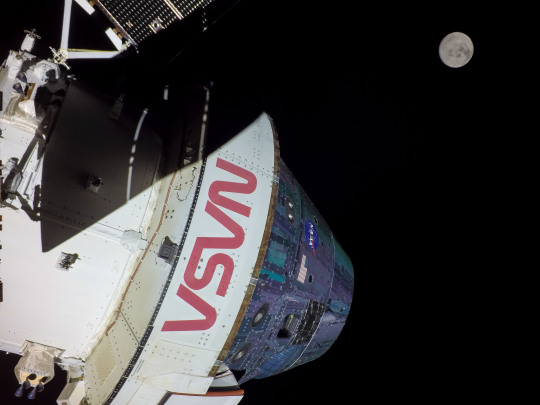
1. Space communication networks helped the Artemis I mission on its historic journey to the Moon. From the launch pad to the Moon and back, the Near Space Network and Deep Space Network worked hand-in-hand to seamlessly support Artemis I. These networks let mission controllers send commands up to the spacecraft and receive important spacecraft health data, as well as incredible images of the Moon and Earth.
The Pathfinder Technology Demonstration 3 spacecraft with hosted TeraByte InfraRed Delivery (TBIRD) payload communicating with laser links down to Earth. Credit: NASA/Ames Research Center
2. Spacecraft can range in size – from the size of a bus to the size of a cereal box. In May 2022, we launched a record-breaking communication system the size of a tissue box. TBIRD showcases the benefits of a laser communications system, which uses infrared light waves rather than radio waves to communicate more data at once. Just like we have upgraded from 3G to 4G to 5G on our phones, we are upgrading its space communications capabilities by implementing laser comms!

3. The Deep Space Network added a new 34-meter (111-foot) antenna to continue supporting science and exploration missions investigating our solar system and beyond. Deep Space Station 53 went online in February 2022 at our Madrid Deep Space Communications Complex. It is the fourth of six antennas being added to expand the network’s capacity.

4. You’ve probably seen in the news that there are a lot of companies working on space capabilities. The Near Space Network is embracing the aerospace community’s innovative work and seeking out multiple partnerships. In 2022, we met with over 300 companies in hopes of beginning new collaborative efforts and increasing savings.

5. Similar to TBIRD, we're developing laser comms for the International Space Station. The terminal will show the benefits of laser comms while using a new networking technique called High Delay/Disruption Tolerant Networking that routes data four times faster than current systems. This year, engineers tested and proved the capability in a lab.

6. In 2021, we launched the James Webb Space Telescope, a state-of-the-art observatory to take pictures of our universe. This year, the Deep Space Network received the revolutionary first images of our solar system from Webb. The telescope communicates with the network’s massive antennas at three global complexes in Canberra, Australia; Madrid, Spain; and Goldstone, California.
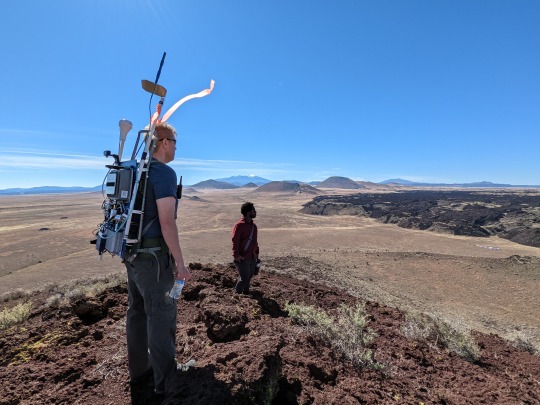
7. Just like we use data services on our phone to communicate, we'll do the same with future rovers and astronauts exploring the Moon. In 2022, the Lunar LTE Studies project, or LunarLiTES, team conducted two weeks of testing in the harsh depths of the Arizona desert, where groundbreaking 4G LTE communications data was captured in an environment similar to the lunar South Pole. We're using this information to determine the best way to use 4G and 5G networking on the Moon.
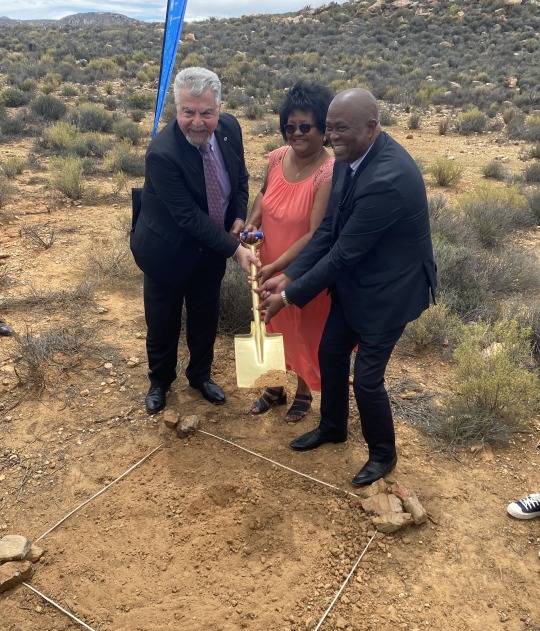
8. A new Near Space Network antenna site was unveiled in Matjiesfontein, South Africa. NASA and the South African Space Agency celebrated a ground-breaking at the site of a new comms antenna that will support future Artemis Moon missions. Three ground stations located strategically across the globe will provide direct-to-Earth communication and navigation capabilities for lunar missions.

9. Quantum science aims to better understand the world around us through the study of extremely small particles. April 14, 2022, marked the first official World Quantum Day celebration, and we participated alongside other federal agencies and the National Quantum Coordination Office. From atomic clocks to optimizing laser communications, quantum science promises to greatly improve our advances in science, exploration, and technology.

10. We intentionally crashed a spacecraft into an asteroid to test technology that could one day be used to defend Earth from asteroids. The Double Asteroid Redirection Test, or DART, mission successfully collided with the asteroid Dimorphos at a rate of 4 miles per second (6.1 kilometers per second), with real-time video enabled by the Deep Space Network. Alongside communications and navigation support, the global network also supports planetary defense by tracking near-Earth objects.
We look forward to many more special moments connecting Earth to space in the coming year.
Make sure to follow us on Tumblr for your regular dose of space!
1K notes
·
View notes
Text
WHAT IS INSIDE THE MOON??
Blog#340
Saturday, October 14th, 2023
Welcome back,
Well, the verdict is in. The Moon is not made of green cheese after all.
A thorough investigation published back in May has found that the inner core of the Moon is, in fact, a solid ball with a density similar to that of iron. This, researchers hope, will help settle a long debate about whether the Moon's inner heart is solid or molten, and lead to a more accurate understanding of the Moon's history – and, by extension, that of the Solar System.

"Our results," wrote a team led by astronomer Arthur Briaud of the French National Centre for Scientific Research in France, "question the evolution of the Moon magnetic field thanks to its demonstration of the existence of the inner core and support a global mantle overturn scenario that brings substantial insights on the timeline of the lunar bombardment in the first billion years of the Solar System."

Probing the interior composition of objects in the Solar System is most effectively accomplished through seismic data. The way acoustic waves generated by quakes move through and reflect from material inside a planet or moon can help scientists create a detailed map of the object's interior.
We happen to have lunar seismic data collected by the Apollo mission, but its resolution is too low to accurately determine the inner core's state. We know there is a fluid outer core, but what it encompasses remains under debate. Models of a solid inner core and an entirely fluid core work equally well with the Apollo data.

To figure it out once and for all, Briaud and his colleagues collected data from space missions and lunar laser ranging experiments to compile a profile of various lunar characteristics. These include the degree of its deformation by its gravitational interaction with Earth, the variation in its distance from Earth, and its density.
Next, they conducted modeling with various core types to find which matched most closely with the observational data.

They made several interesting findings. Firstly, the models that most closely resembled what we know about the Moon describe active overturn deep inside the lunar mantle. This means that denser material inside the Moon falls towards the center, and less dense material rises upwards. This activity has long been proposed as a way of explaining the presence of certain elements in volcanic regions of the Moon. The team's research adds another point in the "for" tally of evidence.

And they found that the lunar core is very similar to that of Earth – with an outer fluid layer and a solid inner core. According to their modeling, the outer core has a radius of about 362 kilometers (225 miles), and the inner core has a radius of about 258 kilometers (160 miles). That's about 15 percent of the entire radius of the Moon.
The inner core, the team found, also has a density of about 7,822 kilograms per cubic meter. That's very close to the density of iron.

Curiously, in 2011 a team led by NASA Marshall planetary scientist Renee Weber found a similar result using what were then state-of-the-art seismological techniques on Apollo data to study the lunar core. They found evidence of a solid inner core with a radius of about 240 kilometers, and a density about 8,000 kilograms per cubic meter.
Their results, Briaud and his team say, is confirmation of those earlier findings, and constitute a pretty strong case for an Earth-like lunar core.

And this has some interesting implications for the Moon's evolution.
We know not long after it formed, the Moon had a powerful magnetic field, which started to decline about 3.2 billion years ago. Such a magnetic field is generated by motion and convection in the core, so what the lunar core is made of is deeply relevant to how and why the magnetic field disappeared.
Given humanity's hope to return to the Moon in relatively short order, perhaps we won't have long to wait for seismic verification of these findings.
Originally published on www.sciencealert.com
COMING UP!!
(Wednesday, October 18th, 2023)
"IS THE MOON RUSTING??"
#astronomy#outer space#alternate universe#astrophysics#universe#spacecraft#white universe#space#parallel universe#astrophotography
73 notes
·
View notes
Text

NASA Artemis science, first intuitive machines flight head to moon
A suite of NASA science instruments and technology demonstrations is on the way to our nearest celestial neighbor for the benefit of humanity. Through this flight to the moon, they will provide insights into the lunar surface environment and test technologies for future landers and Artemis astronauts.
At 1:05 a.m. EST on Thursday, Intuitive Machines' Nova-C lander launched on a SpaceX Falcon 9 rocket from Launch Complex 39A at the agency's Kennedy Space Center in Florida. At approximately 1:53 a.m., the lander deployed from the Falcon 9 second stage. Teams confirmed it made communications contact with the company's mission operations center in Houston. The spacecraft is stable and receiving solar power.
These deliveries are part of NASA's CLPS (Commercial Lunar Payload Services) initiative and Artemis campaign, which includes new solar system science to better understand planetary processes and evolution, search for evidence of water and other resources, and support long-term human exploration.
"NASA scientific instruments are on their way to the moon—a giant leap for humanity as we prepare to return to the lunar surface for the first time in more than half a century," said NASA Administrator Bill Nelson. "These daring moon deliveries will not only conduct new science at the moon, but they are supporting a growing commercial space economy while showing the strength of American technology and innovation. We have so much to learn through CLPS flights that will help us shape the future of human exploration for the Artemis Generation."
While enroute to the moon, NASA instruments will measure the quantity of cryogenic engine fuel as it is used, and during descent toward the lunar surface, they will collect data on plume-surface interactions and test precision landing technologies.
Once on the moon, NASA instruments will focus on investigating space weather/lunar surface interactions and radio astronomy. The Nova-C lander also will carry retroreflectors contributing to a network of location markers on the moon for communication and navigation for future autonomous navigation technologies.
NASA science aboard the lander includes:
Lunar Node 1 Navigation Demonstrator: A small, CubeSat-sized experiment that will demonstrate autonomous navigation that could be used by future landers, surface infrastructure, and astronauts, digitally confirming their positions on the moon relative to other spacecraft, ground stations, or rovers on the move.
Laser Retroreflector Array: A collection of eight retroreflectors that enable precision laser ranging, which is a measurement of the distance between the orbiting or landing spacecraft to the reflector on the lander. The array is a passive optical instrument and will function as a permanent location marker on the moon for decades to come.
Navigation Doppler Lidar for Precise Velocity and Range Sensing: A Lidar-based (Light Detection and Ranging) guidance system for descent and landing. This instrument operates on the same principles of radar but uses pulses from a laser emitted through three optical telescopes. It will measure speed, direction, and altitude with high precision during descent and touchdown.
Radio Frequency Mass Gauge: A technology demonstration that measures the amount of propellant in spacecraft tanks in a low-gravity space environment. Using sensor technology, the gauge will measure the amount of cryogenic propellant in Nova-C's fuel and oxidizer tanks, providing data that could help predict fuel usage on future missions.
Radio-wave Observations at the Lunar Surface of the Photoelectron Sheath: The instrument will observe the moon's surface environment in radio frequencies, to determine how natural and human-generated activity near the surface interacts with and could interfere with science conducted there.
Stereo Cameras for Lunar Plume-Surface Studies: A suite of four tiny cameras to capture imagery showing how the moon's surface changes from interactions with the spacecraft's engine plume during and after descent.
Intuitive Machines' Nova-C-class lunar lander, named Odysseus, is scheduled to land on the moon's South Pole region near the lunar feature known as Malapert A on Thursday, Feb. 22. This relatively flat and safe region is within the otherwise heavily cratered southern highlands on the side of the moon visible from Earth. Landing near Malapert A will also help mission planners understand how to communicate and send data back to Earth from a location where Earth is low on the lunar horizon.
The NASA science aboard will spend approximately seven days gathering valuable scientific data about Earth's nearest neighbor, helping pave the way for the first woman and first person of color to explore the moon under Artemis.
IMAGE....A SpaceX Falcon 9 rocket carrying Intuitive Machines’ Nova-C lunar lander lifts off from Launch Pad 39A at NASA’s Kennedy Space Center in Florida at 1:05 a.m. EST on Feb. 15, 2024. As part of NASA’s CLPS (Commercial Lunar Payload Services) initiative and Artemis campaign, Intuitive Machines’ first lunar mission will carry NASA science and commercial payloads to the moon to study plume-surface interactions, space weather/lunar surface interactions, radio astronomy, precision landing technologies, and a communication and navigation node for future autonomous navigation technologies. Credit: NASA
11 notes
·
View notes
Text
diving headfirst into oblivion, ravenous predator pilots (longer story under the cut)
accel weapons have long since been outlawed, but that doesn't stop one or two from being kept in back pockets. this particular one — you don't know how it was kept under wraps. an affected area this size? inspection teams should've been able to sniff it out. hell, a satellite scan could've picked up the temporal haze.
no matter. the cloudy gray orb hangs there now where most of a moon used to be, already aged to cosmic dust. the crumbling remains spared the blast now plummet towards the world below. a regional extinction event at the least.
heavy-handed. the enemy defense fleet still remains though, too spared the blast and with little left to lose. "hellion 5, do you read? there's a warsuit on your tail, looks like one of the praetors," came the voice of someone in operations over the radio. then, your handler's voice: "hound, divert course. bait that praetor away from the rest of the squad and put it down." you acknowledge and veer off course towards where this praetor is supposedly hiding — blindspots in your radar drawn by beams of temporal haze. whoever this pilot is, they're clever.
"hellion 5, looks like the bogey's taking the bait. id reads praetor I, fable." "praetor I. you've got your work cut out for you, hound. don't disappoint." you won't disappoint. not now. you put all else out of your mind — here, away from the larger battle, it's just you and your target. praetor 1 fable is quick. the fastest warsuit lunar regime money can buy. you've been waiting for this.
time loses meaning in a fight like this. each life-and-death moment its own self-contained war. you and praetor I trade missiles and energy blades. railguns. and support drones. hails of lasers and oversized conventional rounds. toe-to-toe, until — a railround tears through your warsuit's shoulder, taking the arm with it. fable, silent until now, hails your warsuit, taunting and sadistic. hungry. "don't tell me that's all you've got, mutt. you were just getting fun."
in your feral, violence-addled brain, an idea emerges. one-armed and nearly out of munitions, speed is the only way to win. you need more. you snarl back across the radio and break away, pushing your thrusters to their limits. straight towards the hanging orb — the accel weapon's lingering blast. fable follows suit, couldn't resist if it wanted to.
grey haze begins to cloud your exterior vision. temporal haze. time distortion. dispersed at this range from the epicenter, they're fairly weak. hazardous, but not the edge you need. deeper. fable pursues and... appears slower. "into the blast? bold move, hound. be careful, or you might not come back." your handler's voice, but distorted. slowed down. the plan is working, but you need to go deeper. sensors scrambled by the haze, you turn them off. all you need are your eyes and an opening. your warsuit rattles and groans under the bombardment of the haze. before long it'll start to disintegrate — aged to dust by the accel weapon's blast just like the moon. not much longer now. the trick, at least in theory, is turning away while your brain can still process the flow of time. no one's willingly dived into an accel weapon's boundaries before. there's a reason they're outlawed.
your radio crackles to life again, displaying praetor I fable once more, but all that comes through is a deep rumbling. paint and exterior plating flakes off your warsuit into nothingness. fable's is an ant in your rearview, and just as slow. it's time. you burn hard, priming your energy blade and urging your thrusters to share your hunger. you hurdle towards fable's warsuit, and its voice over the radio becomes clearer and clearer, mad and frothing and ravenous. "–never cared for them or their 'ideals.' you're just like me, hound. i can smell it right through your warsuit. yes, a real predator! come, give me a–"
and then, naught but static. warsuit still cloaked and sticky with temporal haze, you accelerate faster than any warsuit likely ever has, cleaving praetor I fable in two at a respectable percentage of the speed of light and leaving your own an inert and twisted mass of fused metal floating through space. true to your promise, you don't disappoint.
12 notes
·
View notes
Text
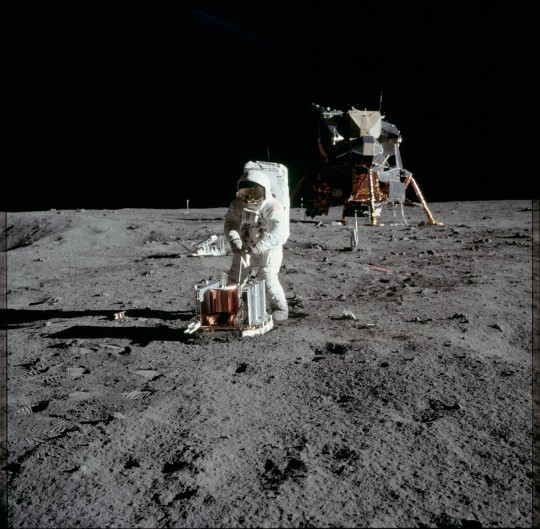
"Astronaut Edwin E. 'Buzz' Aldrin Jr., Lunar Module pilot, is photographed during the Apollo 11 extravehicular activity on the Moon.

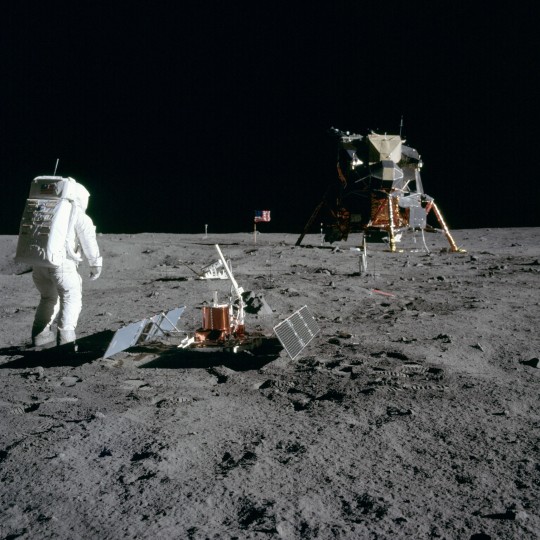
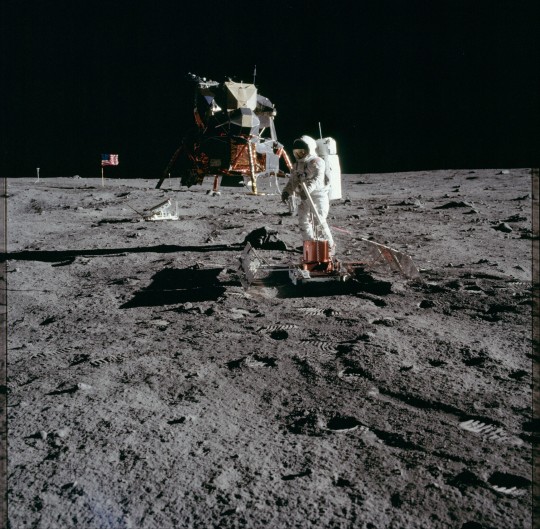
He has just deployed the Early Apollo Scientific Experiments Package (EASEP). In the background is the United States flag; in the left background is the black and white lunar surface television camera; in the far right background is the Lunar Module 'Eagle'.
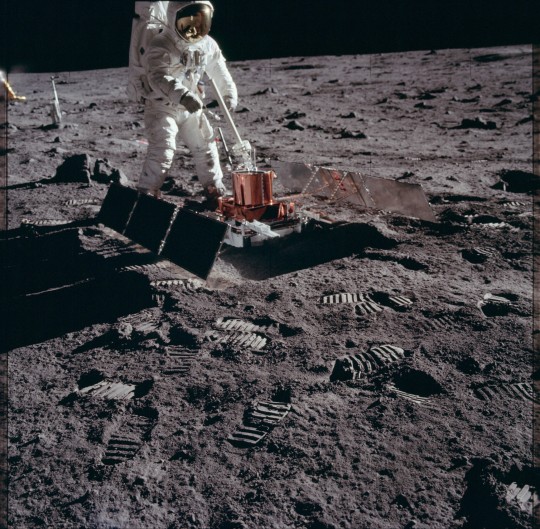
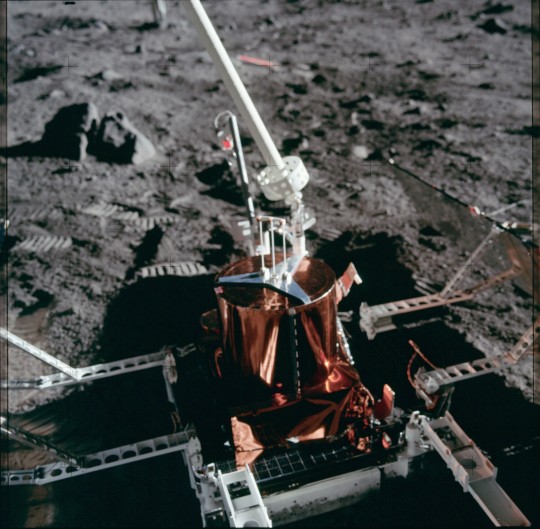
In the foreground is the Passive Seismic Experiment Package (PSEP).

Beyond it is the Laser Ranging Retro-Reflector (LR-3). Astronaut Neil A. Armstrong, commander, took this photograph with a 70mm lunar surface camera."
Date: July 20, 1969
NASA ID: AS11-40-5946, AS11-40-5947, AS11-40-5948, AS11-40-5949, AS11-40-5950, AS11-40-5951, AS11-40-5953, AS11-40-5952
#Apollo 11#Lunar Module#LM-5#Eagle#Apollo Program#moon landing#moon#July#1969#NASA#my post#Buzz Aldrin
97 notes
·
View notes
Link
A SpaceX Falcon 9 rocket carrying Intuitive Machines’ Nova-C lunar lander lifts off from Launch Pad 39A at NASA’s Kennedy Space Center in Florida at 1:05 a.m. EST on Feb. 15, 2024. As part of NASA’s CLPS (Commercial Lunar Payload Services) initiative and Artemis campaign, Intuitive Machines’ first lunar mission will carry NASA science and commercial payloads to the Moon to study plume-surface interactions, space weather/lunar surface interactions, radio astronomy, precision landing technologies, and a communication and navigation node for future autonomous navigation technologies. A suite of NASA science instruments and technology demonstrations is on the way to our nearest celestial neighbor for the benefit of humanity. Through this flight to the Moon, they will provide insights into the lunar surface environment and test technologies for future landers and Artemis astronauts. At 1:05 a.m. EST on Thursday, Intuitive Machines’ Nova-C lander launched on a SpaceX Falcon 9 rocket from Launch Complex 39A at the agency’s Kennedy Space Center in Florida. At approximately 1:53 a.m., the lander deployed from the Falcon 9 second stage. Teams confirmed it made communications contact with the company’s mission operations center in Houston. The spacecraft is stable and receiving solar power. These deliveries are part of NASA’s CLPS (Commercial Lunar Payload Services) initiative and Artemis campaign, which includes new solar system science to better understand planetary processes and evolution, search for evidence of water and other resources, and support long-term human exploration. “NASA scientific instruments are on their way to the Moon – a giant leap for humanity as we prepare to return to the lunar surface for the first time in more than half a century,” said NASA Administrator Bill Nelson. “These daring Moon deliveries will not only conduct new science at the Moon, but they are supporting a growing commercial space economy while showing the strength of American technology and innovation. We have so much to learn through CLPS flights that will help us shape the future of human exploration for the Artemis Generation.” While enroute to the Moon, NASA instruments will measure the quantity of cryogenic engine fuel as it is used, and during descent toward the lunar surface, they will collect data on plume-surface interactions and test precision landing technologies. Once on the Moon, NASA instruments will focus on investigating space weather/lunar surface interactions and radio astronomy. The Nova-C lander also will carry retroreflectors contributing to a network of location markers on the Moon for communication and navigation for future autonomous navigation technologies. NASA science aboard the lander includes: Lunar Node 1 Navigation Demonstrator: A small, CubeSat-sized experiment that will demonstrate autonomous navigation that could be used by future landers, surface infrastructure, and astronauts, digitally confirming their positions on the Moon relative to other spacecraft, ground stations, or rovers on the move. Laser Retroreflector Array: A collection of eight retroreflectors that enable precision laser ranging, which is a measurement of the distance between the orbiting or landing spacecraft to the reflector on the lander. The array is a passive optical instrument and will function as a permanent location marker on the Moon for decades to come. Navigation Doppler Lidar for Precise Velocity and Range Sensing: A Lidar-based (Light Detection and Ranging) guidance system for descent and landing. This instrument operates on the same principles of radar but uses pulses from a laser emitted through three optical telescopes. It will measure speed, direction, and altitude with high precision during descent and touchdown. Radio Frequency Mass Gauge: A technology demonstration that measures the amount of propellant in spacecraft tanks in a low-gravity space environment. Using sensor technology, the gauge will measure the amount of cryogenic propellant in Nova-C’s fuel and oxidizer tanks, providing data that could help predict fuel usage on future missions. Radio-wave Observations at the Lunar Surface of the Photoelectron Sheath: The instrument will observe the Moon’s surface environment in radio frequencies, to determine how natural and human-generated activity near the surface interacts with and could interfere with science conducted there. Stereo Cameras for Lunar Plume-Surface Studies: A suite of four tiny cameras to capture imagery showing how the Moon’s surface changes from interactions with the spacecraft’s engine plume during and after descent. Intuitive Machines’ Nova-C-class lunar lander, named Odysseus, is scheduled to land on the Moon’s South Pole region near the lunar feature known as Malapert A on Thursday, Feb. 22. This relatively flat and safe region is within the otherwise heavily cratered southern highlands on the side of the Moon visible from Earth. Landing near Malapert A will also help mission planners understand how to communicate and send data back to Earth from a location where Earth is low on the lunar horizon. The NASA science aboard will spend approximately seven days gathering valuable scientific data about Earth’s nearest neighbor, helping pave the way for the first woman and first person of color to explore the Moon under Artemis. Learn more about NASA’s CLPS initiative at: https://www.nasa.gov/clps -end- Karen Fox / Alise FisherHeadquarters, Washington202-358-1600 / [email protected] / [email protected] Nilufar RamjiJohnson Space Center, [email protected] Antonia JaramilloKennedy Space Center, [email protected] Share Details Last Updated Feb 15, 2024 LocationNASA Headquarters Related TermsMissionsArtemisCommercial Lunar Payload Services (CLPS)
3 notes
·
View notes
Text
New guinea pig alert!
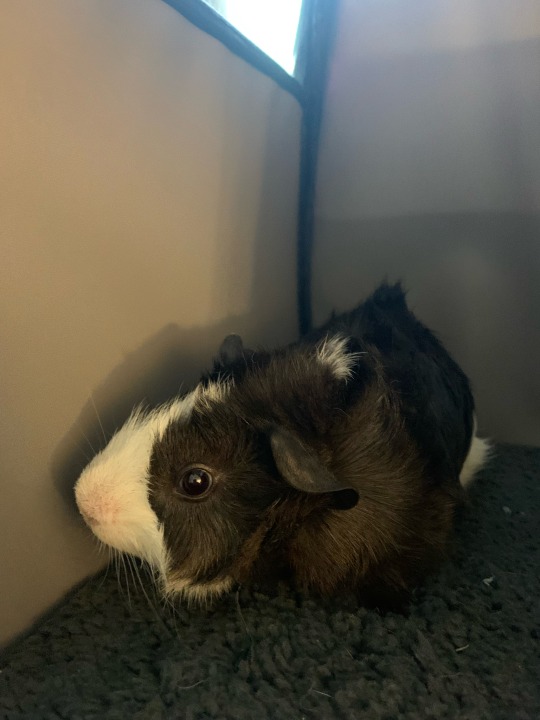
This is Lunar Laser Ranging Experiment
But you can call him Eclipse
7 notes
·
View notes
Text
Okay quick Chandrayaan 3 brainrot post again: can we talk about Pragyan please? Pragyan is literally the most adorable thing, that one lil robot on wheels can do so much! Here are some fun facts!
Pragyan has a payload called the APXS or the Alpha Particle X Ray spectrometer. It literally irradiates moon rocks and gets back the composition of what it contains! (Massive oversimplification) That little thing can do so much and it only weighs 26 kgs!
It has a shelf life of 1 lunar day or 14 earth days. And it travels at 1cm/s speed. If you're looking at the Moon's dark side right now, provided it is nighttime, you'll likely be looking at this lil thing taking baby steps and exploring the moon's surface all on its own!
They've fitted the rover with so many solar panels so there's no power disturbance. The reason for a short shelf life has to do a lot with how much solar energy it gets (again massive oversimplification) and there are often constraints to work with. There's been talks on improving the shelf life and recommendations but can I just take a moment to appreciate ISRO for being able to carry out so many precise experiments in this lil guy in a short span of 2 weeks?
Pragyan also has something called Laser Induced Breakdown Spectroscopy or LIBS which literally breaks down surface materials with lasers, measures the fucking plasma vapours AND REPORTS IT BACK TO SRIHARIKOTA/BANGALORE MISSION CONTROL.
It's total power generation is about 50 watts, has six wheels, has a camera and has a dimension of 3 feet x 2.5 feet x 2.8 feet.
The Pragyan wheels have this stamp of ISRO's logo and the Ashoka emblem on the lunar surface, thus cementing it on the soil forever!!
I'm not sure if Pragyan 2 will visit the crash site of CY-2 (Vikram 1 and Pragyan 1 ended up crash-landing about 600km from the South Pole) and I don't know if it is within the realm of possibility, since Pragyan 2 has a maximum range of 500m within the place where they're interested in conducting the in-situ science experiments, but it would have been a real homecoming moment. To think that it took ISRO 3 and a half years (2 shaved off due to the pandemic) to come up with a design solution to do the unthinkable and make some powerful discoveries is just..
I need a moment lol. I've already cried like six times, I do not want this to be the seventh.
And here are some images!




6 notes
·
View notes
Text
Odysseus Mission To End Early After Awkward Landing On Moon
The lunar lander got stuck...
And while she’s lying on one side with a broken leg, telemetry is being received and it is continuing to function. As I record, the team are entering their sixth day of the eight-day mission of providing NASA valuable scientific data.
An analysis of the decent flight path has revealed that the one-meter-per-second landing with laser range-finding was actually three times faster with optical…

View On WordPress
0 notes
Text
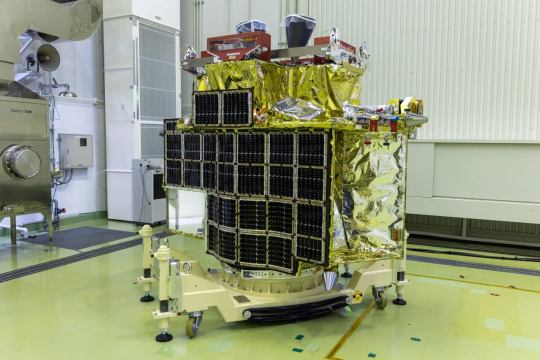
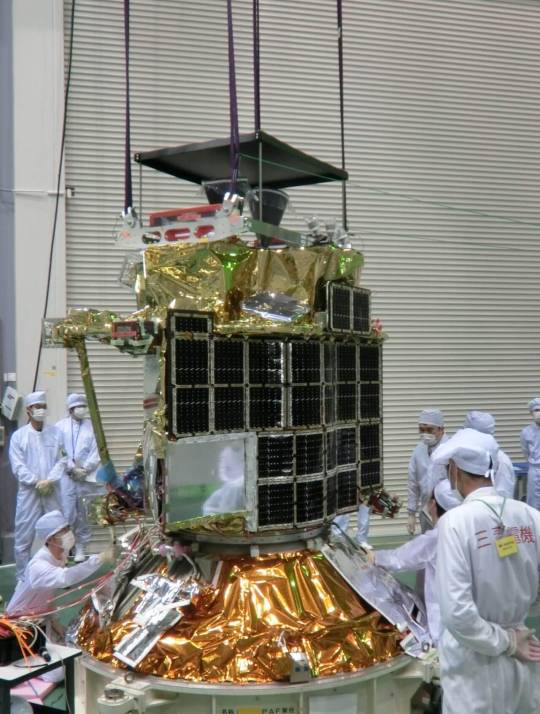
Landing today (I'd forgot about this one...shock) is Japan's SLIM or Smart Lander for Investigating Moon which was launched on 6 Sept 2023.
Landing coverage is from 2pm GMT with the descent commencing at 3pm for a landing at 3:20pm... coverage (usually with alternating english) at... (see below)
SLIM is designed to land precisely within 100m of any given scientific target, even individual rocks identified previously by Lunar orbiters, such as Kaguya or NASA's LRO. Rather than having to land somewhere in a wide relatively flat landing zone of several km in area and then having to employ a rover of some kind to get to the area of interest.
SLIM is also designed to land on a slope, something which would present a challange for most current rover designs to climb up.
To reduce weight the main fuel tank of the craft is used as the actual structure of the vehicle (similar to how formula one cars began using the engine and gearbox of the car as the structure instead of a chassis) and lightweight thin film solar arrays, from Sharp Corporation, which can be wrapped around exsisting structures and attached using Velcro. The propellent tank also contains both oxidiser and fuel separated by a lightweight diaphragm made of PTFE (Teflon) instead of using separate tanks for each.
The lander is equiped with a Mitsubishi microwave radar for altitude and doppler velocity estimation which can be used from several km down to tens of meters. A Mitsubishi Laser Range-Finder (LRF) for altitude determination.
Plus two Meisei lightweight terrain naviigation Cameras (CAM), one is used during powered descent and the other for vertical descent.
Because SLIM is designed to be capable of landing on slopes it has a unique landing method, after descending it will hover briefly then tip over to present a spherical landing pad to the surface mounted on one corner of the base of the craft. On contact the craft will continue to tip over onto four other apherical pads so it lands on its side. The spherical pads are made from a crushable metal mesh which will absorb the landing energy.
Two small rovers will also be ejected from SLIM just before touchdown...
LEV 1 is a hopper, which will move around using a spring leg
and LEV 2 is a small ball like rover
SLIM Mass: 200kg (dry) 700-730kg (fuelled)
Dimensions: 2.4m x 1.7m x 2.7m
Engines: Two Mitsubishi KYOCERA 500N thrust main bi-propellent engines with a high performance ceramic combustion chamber giving a high thrust range and pulse operation capabilty. Plus twelve IHI 20N thrusters for attitude control and precision maneuvering. Pics: JAXA
1 note
·
View note
Text
2023 Dec 25
Another set of songs that definitely range all over the map. I don't do notes on the whole playlist all the time, but this week I'm apparently gonna.
It's actually hard to find a place to put "I'm Gonna Tell My Therapist On You" because it, in my mind, is nearly a perfect song and anything up against it is gonna have a hard time. So, you know, I put it first. Lol.
"Fascination" builds on this playlist's character of a (gender neutral) fuckboi
"Sinner Love" and "Reveries" both kinda work together because you could put a killer burlesque routine to them, or to have like a really heavy fuck scene in a movie.
"IF U C My Enemies", "Ready for Combat", and "Superhero" all kinda hit the points of someone preparing (or not) for a fight. Very different vibes but a similar core theme.
"Punk Rick Kitty Cat" is just a song you should listen to. ¯\_(ツ)_/¯ . It is especially hilarious as a follow-up/answer to "Superhero"
Sometimes the randomizer means you get two songs from the same artist two weeks in a row. Still good stuff tho.
and Thanks! I Hate It! should win awards on song titles alone, but they put out some kick ass music.
This week’s playlist:
I'm Gonna Tell My Therapist On You by Pinkshift
Fascination by The Beaches
Sinner Love by Sapphic Lasers
Reveries by Bones & Bridges
If U C My Enemies by Rubblebucket
Ready for Combat by Icon for Hire
Superhero by Johnny Hollow
Punk Rock Kitty Cat by The Nearly Deads
Punch Drunk Destiny by I Fight Dragons
Opossum! My Possum! by Thanks! I Hate It
Lunar Rotation Weekly by Winifred Yost
#discover music#discovery#lunar rotation#music#music monday#song#songs#new music#pinkshift#the beaches#sapphic lasers#bones & bridges#rubblebucket#icon for hire#johnny hollow#the nearly deads#I fight dragons#thanks! i hate it
1 note
·
View note
Text
ILLUMA-T launches to the International Space Station
New Post has been published on https://thedigitalinsider.com/illuma-t-launches-to-the-international-space-station/
ILLUMA-T launches to the International Space Station
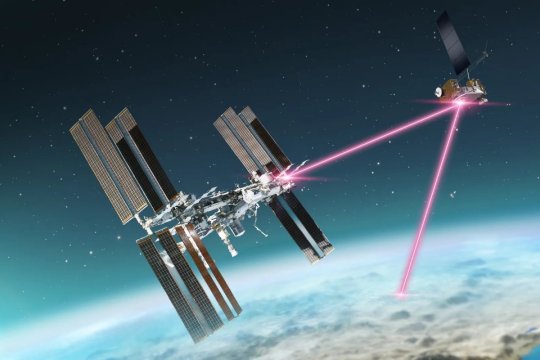

On Nov. 9, a Lincoln Laboratory–developed laser communications terminal integrated on a NASA-built payload was launched aboard a SpaceX Falcon 9 vehicle. Cameras inside the launch vehicle enabled the laboratory and a NASA Goddard Space Flight Center team to watch as the payload headed for the International Space Station (ISS), a football-field-sized research platform orbiting Earth about 250 miles above its surface, an altitude known as low Earth orbit (LEO).
On the ISS, the terminal — called ILLUMA-T (for Integrated Laser Communications Relay Demonstration LEO User Modem and Amplifier Terminal) — will participate in a technology demonstration to showcase the advantages of laser communications for missions in LEO. The team seeks to demonstrate that ILLUMA-T can enable high data-transmission rates from the ISS to NASA’s Laser Communications Relay Demonstration (LCRD) satellite in geosynchronous orbit (GEO) and ultimately to ground stations on Earth, and also from the ground back up to the ISS.
“We’re excited for ILLUMA-T and LCRD to demonstrate NASA’s first LEO-GEO optical communications relay,” says Bryan Robinson, an associate leader of the laboratory’s Optical and Quantum Communication Technology Group. “Our close collaboration with Goddard on engineering development and operations was critical to this mission.”
Lighting the way for future space communication
Most space-based missions today use radio frequencies (RF) for communication. But infrared laser light (owing to its shorter wavelength) can transmit data at rates 10 to 100 times faster. This speedup means missions can send more data — for example, images, videos, sensor outputs, and command-and-control information — to and from space in much less time. Laser communications systems also require less volume, weight, and power than their RF counterparts, translating to lower mission costs.
NASA first performed two-way space communication with laser light instead of RF in 2013 with the Lunar Laser Communications Demonstration (LLCD), for which the laboratory designed and built the space and ground terminals. That year, LLCD made history by transmitting data at record-breaking download and upload rates over the 239,000 miles between the moon and Earth (more specifically, to a laboratory-built ground station in New Mexico). As LLCD was winding down, NASA embarked on another laser communications development effort: LCRD. Goddard built the two laser communications terminals for LCRD based on the LLCD design. Since launching into GEO 22,000 miles above Earth’s surface in 2021, LCRD has been relaying data between ground stations in Hawaii (built by the laboratory) and in California (built by Caltech’s Jet Propulsion Laboratory), with NASA conducting experiments and assessing system performance.
“The next question NASA asked as they finished LLCD and invested in LCRD was whether the LLCD terminal design could be put onto a LEO spacecraft,” Robinson says. “The ISS was always the target for that demonstration.”
Redesigning the terminal
The design of the LLCD terminal was constrained in some ways that made its transfer onto a LEO satellite difficult. The biggest constraint was related to its field of regard, or the directions in which the terminal can point when LCRD is within sight of the LEO satellite. As a LEO satellite orbits the Earth (about once every 90 minutes), the laser beam must be moved quickly to stay pointing toward a GEO satellite over all angles. However, the original terminal design was limited to about 20-degrees motion in both the vertical and horizontal directions.
“That range of motion works great in GEO because the satellite is in a fixed position; it’s not moving relative to the Earth, and the extent of Earth is within those 20 degrees,” Robinson explains. “So, you can point anywhere on Earth and you don’t have to move very fast.”
The laboratory team started reworking the terminal design after the LLCD program completed operations in 2014. They added a two-axis gimbal (pivoted support that allows an object to rotate about an axis) capable of pointing anywhere in the hemisphere of directions as the satellite moves through LEO. The gimbal can quickly pivot to track a GEO satellite.
In addition to making the terminal design more functional, the team made it more manufacturable. While coming up with and testing initial concepts, they sought input from industry partners and tailored several aspects of the design accordingly. For example, they incorporated all the fine-pointing mechanisms — such as light-focusing lenses, tracking sensors, and fast-steering mirrors — in a backend optical assembly. In this new design, the mechanisms are slightly larger and easier to align. Such alignment is necessary to precisely point the laser beam in the desired direction for communication, and the team incorporated additional pointing-correction mechanisms to relax the alignment tolerance requirements. The assembly is separated from the telescope, which is exposed to more-extreme space environments, enabling better control of the temperature and pointing stability of the optics.
NASA then initiated an effort to put this terminal, called MAScOT (for Modular, Agile, Scalable Optical Terminal), on the ISS. ILLUMA-T is now bringing MAScOT into space for the very first time.
Embarking on a six-month mission
Over the next two weeks, ILLUMA-T, packaged in an enclosure compatible with ISS interfaces, will be installed on an external module of the ISS, the Japanese Experiment Module – Exposed Facility. Two separate cranes will lift the ILLUMA-T payload into its designated space. Thanks to cameras stationed on the ISS, the team will be able to follow the installation process, unlike previous laser communications missions like LLCD, in which the payload was launched and never seen again.
Once installation is complete, the team will power on ILLUMA-T and perform in-orbit checkouts. Following this one-month commissioning phase, they will attempt to attain first light — that is, when ILLUMA-T transmits its first beam of laser light through its optical telescope to LCRD.
After achieving this critical milestone, the team will begin laser communications experiments to send data from ILLUMA-T on the ISS to LCRD to the ground (return direction) and vice versa (forward direction). They plan to demonstrate a return rate of 1.2 gigabits per second (Gbps) and a forward rate of 51 megabits per second (Mbps), with additional modes operating up to 155 Mbps. These return and forward rates are considerably higher (about two and six times higher, respectively) than those currently provided by radio systems on the ISS and are achieved with a terminal much smaller than the RF terminal.
“High data rates are useful when astronauts are involved in the mission,” says Farzana Khatri, senior staff in the laboratory’s Optical and Quantum Communication Technology Group. “A reliable data link from the ground to space is important for streaming internet and staying connected with the astronauts to perform telehealth, for example. Also, on the ISS are many computers, all of which need to be regularly updated and patched.”
ILLUMA-T, composed of the MAScOT optical module and a modem, is connected via Ethernet to the ISS local area network, which computers and other experiments plug into. So, ILLUMA-T can send various kinds of data from the ISS, such as scientific measurements and system health and status indicators.
“Our goal during the experiments is to ensure the optical links work as expected and provide the defined data rates,” Robinson says.
Employing the terminal design in future missions
The experiments will span five months, after which ILLUMA-T is anticipated to de-orbit from the ISS, with another system taking its place. But ILLUMA-T only represents the initial use of MAScOT. The same terminal design will be employed in the Orion Artemis II Optical Communications System (O2O). Scheduled to launch aboard NASA’s Orion spacecraft in November 2024, O2O will bring laser communications to the moon for the human-crewed Artemis II mission. The four Artemis II astronauts will be the first humans since 1972 to take the trip to the moon. The laboratory team has already built and delivered the optical terminal for O2O to Kennedy Space Center, where it has been installed on Orion and is undergoing testing.
The team is now exploring how MAScOT could be integrated with a high-rate optical modem to support the Event Horizon Explorer (EHE), which requires data link rates of more than 200 Gbps. The Event Horizon Telescope (EHT) captured the first-ever image of a black hole in 2019; the EHE seeks to extend the ground-based EHT with a space-based node in GEO to capture even sharper images, revealing intricate details such as halos of light formed by particles orbiting a black hole. One possibility for the high-rate optical modem is that used for the laboratory-developed TeraByte Infrared Delivery (TBIRD) laser communications payload launched into LEO in 2022. While ILLUMA-T uses a 1.2 Gbps industry-produced modem specifically designed to operate in space and work with the signaling used by the LCRD spacecraft, TBIRD uses an augmented 100 Gbps commercial modem designed for terrestrial fiber-optic networks — the ones that power internet, telephone, and television services across the globe today. TBIRD demonstrated a successful link from LEO to the ground with a very small telescope. However, for EHE and other GEO missions, closing the much-longer link (about 100 times longer) from GEO to the ground with a high-rate commercial modem will require a larger telescope, like that of MAScOT, and higher transmit powers.
“We developed MAScOT to be more flexible than the terminals for LLCD and LCRD,” says Robinson. “Many missions now and in the future are expected to benefit from this new design.”
The ILLUMA-T payload is managed by NASA Goddard. The ISS program office at NASA’s Johnson Space Center is a partner. ILLUMA-T is funded by the Space Communications and Navigation (SCaN) program at NASA Headquarters in Washington.
#000#2022#2024#250#agile#astronauts#back up#black hole#caltech#Cameras#Capture#Collaboration#command#communication#communications#computers#data#Design#details#development#direction#earth#employed#engineering#fiber#flight#Future#gimbal#Health#hemisphere
0 notes
Text
Day 58. Mile 3966. Observatory.
We break camp in the morning to drive up the mountain to the McDonald Observatory. This is another bucket list item! I used to listen to the podcast from this observatory when i lived in North Carolina. I'm excited about seeing their really big telescopes.
Our alternatives to driving the rig are to rent a car at $200 a day. There are no cars available. Anywhere around! The other alternative is to uber up to the Observatory. That is priced out at $70 each way. We won't spend that much in fuel using the rig.
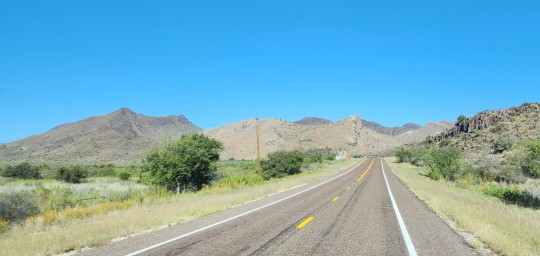


We park at the visitor's center.

We have no cell coverage up here. We take a guided tour which we reserved yesterday.


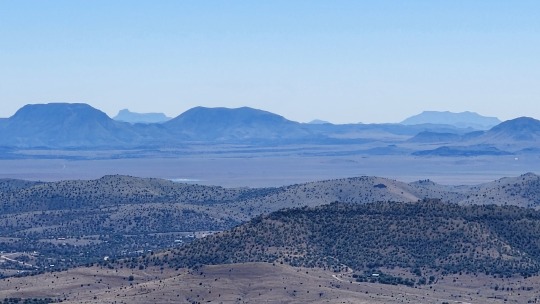
We get to see 2 of the telescopes. 107" and HET. Unbelievably large!
First we check out the 107". It is still used for research. They have added computers and other technology to improve its value. Our guide is very knowledgeable. This is terrific!
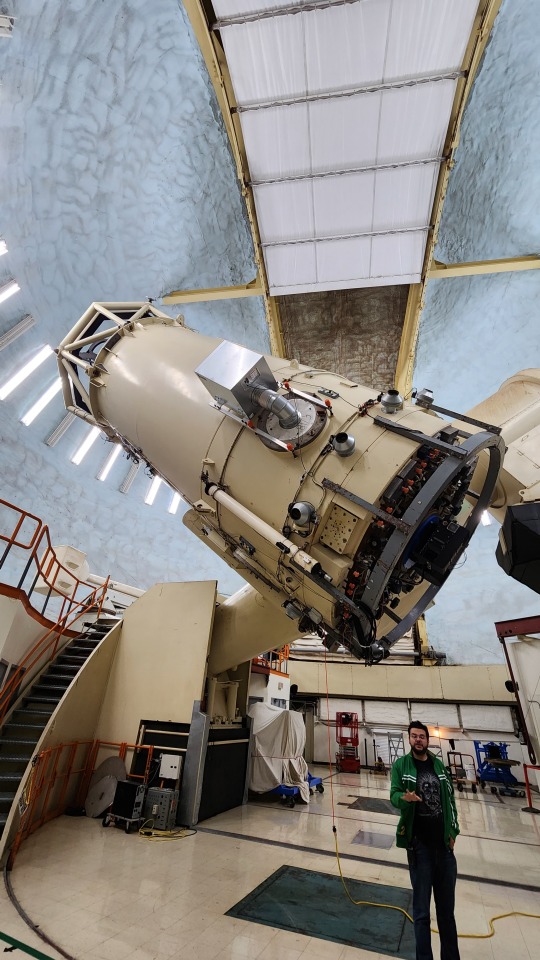
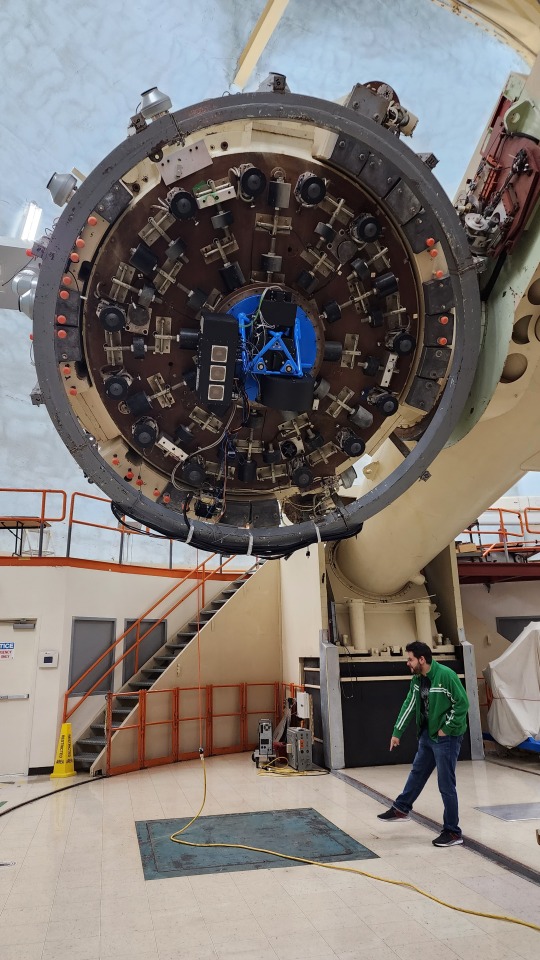
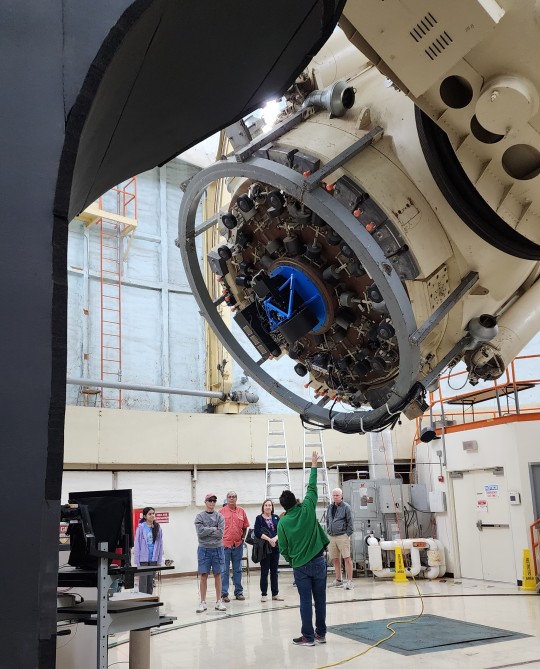
We all have coats on because the temperature inside is at the expected night temp . This allows them to open the roof without having to wait for the telescope to reach the temp of the outside. It is 55 degrees in the room.

Next we visit HET .
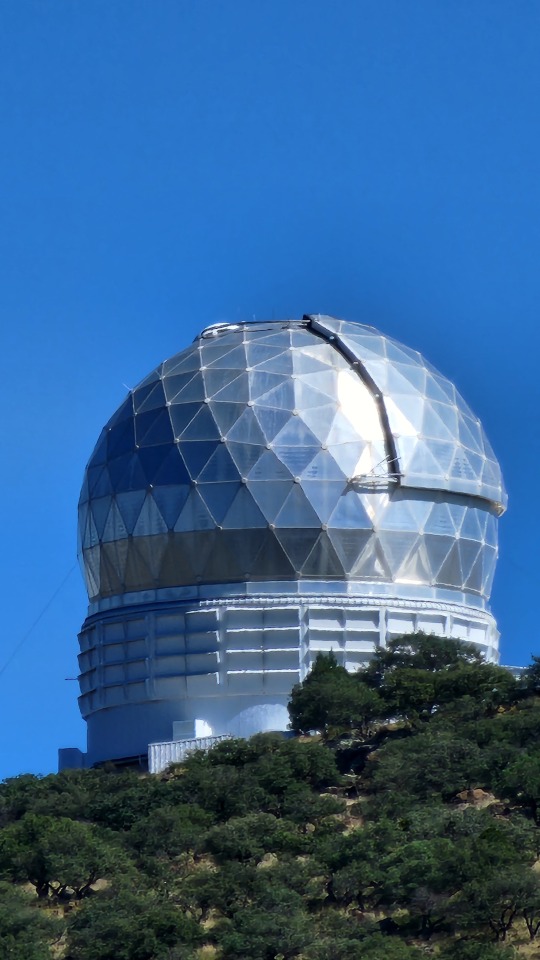
I learn that Robert Eberly '39 Penn State was involved in the HET telescope. Penn State's logo in outside the HET.

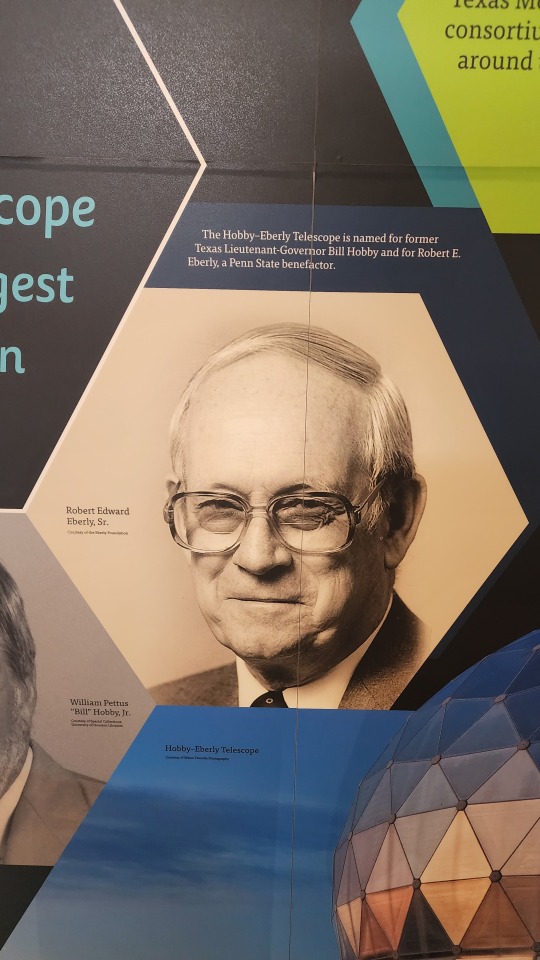

I read about Lunar Laser Ranging. It uses a reflector that is on the moon to measure distances and other things. It accomplishes much more than its original intent. I am impressed with its accomplishments.
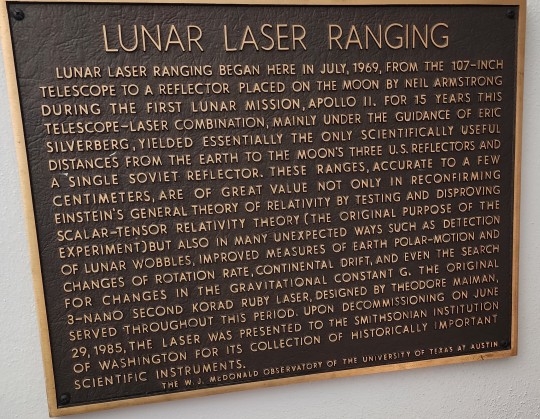
We look down towards the visitors center and we see our rig parked in the lot. Remembering the dogs, we are anxious to get back to walk them and give them a break from being locked up.

After our tour we are surprised to see wild pigs. Or so I think that is what they are. I'm wrong. They are not pigs, or bores. I can't access the internet to find out.


Driving back to the Lost Alaskan is a bit more difficult because alot of it is downhill. We use the engine break to keep our speed under control.


On the ride down the mountain, I find out that the "wild pigs" are Javelinas (members of the Peccary family, a distant relative to a Hippo).
0 notes
Text

Detect gravitational waves with an interferometric seismometer array on lunar nearside
In a groundbreaking development of China's manned lunar missions, the China National Space Administration is calling for possible experiments to leverage the Moon's unique properties in science. Undoubtedly, the astronomical community eagerly embraces this opportunity. A team lead by Department of Astronomy, Beijing Normal University, recently proposed a promising plan to detect gravitational waves (GWs) by putting seismometers on the Moon's surface.
By utilizing the Moon as a Weber bar-style resonant mass, the experiment capitalizes on detecting deci-Hertz gravitational waves. They plan to build an array of small laser interferometric seismometers on the Moon surface. The Moon's natural resonant frequency, ranging between 0.1 and 1Hz, holds the potential for detecting gravitational waves resulting from significant astrophysical events like mergers of intermediate-mass black holes (IMBHs) and collisions of neutron stars. By installing seismometers, it becomes possible to observe changes in the Moon's shape and position caused by the passing of deci-Hertz GWs. This frequency range fills the gap of GW spectrum covered by existing detectors, such as ground-based detectors (LIGO et al.) and ongoing space-based antennas (LISA et al.) which exhibit peak sensitivity at several Hertz and milli-Hertz (10−3 Hz), respectively.
The experiment's design and deployment strategy have been outlined. To monitor the Moon’s translational and rotational motions, they plan to use seismometers that senses six degrees of freedom (DOFs). All mechanical DOFs are weakly cross-coupled. Moreover, a two-stage sensor system is proposed for monitoring the Moon. For the lunar seismic displacement, interferometric sensors are used and for low-frequency and high-DC displacement such as moonquakes, the Birmingham optical sensor and electromagnetic actuator (BOSEM) plays the role. The hardware design could plausibly reach a sensitivity of 10−11 m per square root Hertz. That is, for a signal with the frequency of 1 Hz, the proposed design can detect the minimum vibration of lunar geology is 10−11 m.
The location of the array is also carefully considered. Due to the absence of an atmosphere, the Moon holds significant temperature variations between day and night. Four cold spots were found to satisfy stable, low-temperature conditions. However, the selection of the site depends on the future Moon mission to provide more accurate information.
Redundancies are incorporated in the proposal to address mission challenges. For example, each seismometer has six photodetectors, but only four are necessary for measuring local topography. The deployment pattern of the five seismometers is also carefully designed to capture the local lunar surface deformations and is able to extrapolate to larger deformations in surrounding regions. For the most extreme scenario, only two widely separated seismometers can claim the detection.
However, challenges lie ahead. Overwhelming background thermal seismic noise is not avoidable. Additionally, data acquisition, storage, and processing are challenging. A reliable and high-bandwidth communication link between the seismometers and Earth would demand. Despite these requirements, ongoing advancements and future solutions are anticipated to address these difficulties.
Overall, the proposal to construct an interferometric seismometer array on the Moon for detecting deci-Hertz gravitational waves (GWs) has the potential to contribute to GW physics research and facilitate the exploration of phenomena like IMBHs. Based on the unique environment and characteristics of the Moon, it may advance our understanding of the universe and expand the field of GW astronomy.
IMAGE....Computer-aided design (CAD) model (a) and the top view (b) of the proposed lunar seismometer. The upper mass and pillars are made of aluminum, and the test mass is made of fused silica. The test mass is hung using a single silica fiber with three cubes attached to it. Each cube has two mirrors that monitor the vertical and horizontal motions of the test mass. The golden boxes represent the quasimonolithic component (QMC) cages that contain the optical head; the cages are mounted on the breadboard. The blue disks are BOSEMs. The motion of the mirror cubes is represented using an oblique coordinate system, where r1,2,3 and z1,2,3 represent the displacement of the mirror cube and r1 the unit vector along x. Additionally, rotation Rr1,2,3 without coupling can be indicated by the vertical motion z1,2,3. CREDIT ©Science China Press
6 notes
·
View notes
Text
Embarking on a Lunar Journey: Chandrayaan-3 Unveiled
Chandrayaan-3 is like the next adventure after Chandrayaan-2! It’s all about showing off our ability to safely land and explore on the moon. It’s like taking the next big step in our lunar journey! 🌕🚀 This mission comprises a Lander and Rover configuration, set to launch from SDSC SHAR, Sriharikota, courtesy of the LVM3. The propulsion module will carry this dynamic duo to a 100 km lunar orbit, equipped with the Spectro-polarimetry of Habitable Planet Earth (SHAPE) payload, poised to delve into spectral and polarimetric Earth measurements from lunar orbit.
Insight into Lander and Rover Payloads
The Lander boasts an array of payloads designed to glean valuable insights. From Chandra’s Surface Thermophysical Experiment (ChaSTE) measuring thermal conductivity and temperature, to the Instrument for Lunar Seismic Activity (ILSA) tracking seismic activity, and the Langmuir Probe (LP) estimating plasma density variations – each payload contributes a unique piece to the scientific puzzle. Adding to this, a passive Laser Retroreflector Array from NASA is on board for lunar laser ranging studies.
The Rover is armed with an Alpha Particle X-ray Spectrometer (APXS) and a Laser Induced Breakdown Spectroscope (LIBS), aimed at uncovering the elemental composition in the vicinity of the landing
#breaking news#bbc news - world#entertainment news#latest news#mixed media#news#newsoftheday#headlines today news#new simblr#celebrity news
0 notes